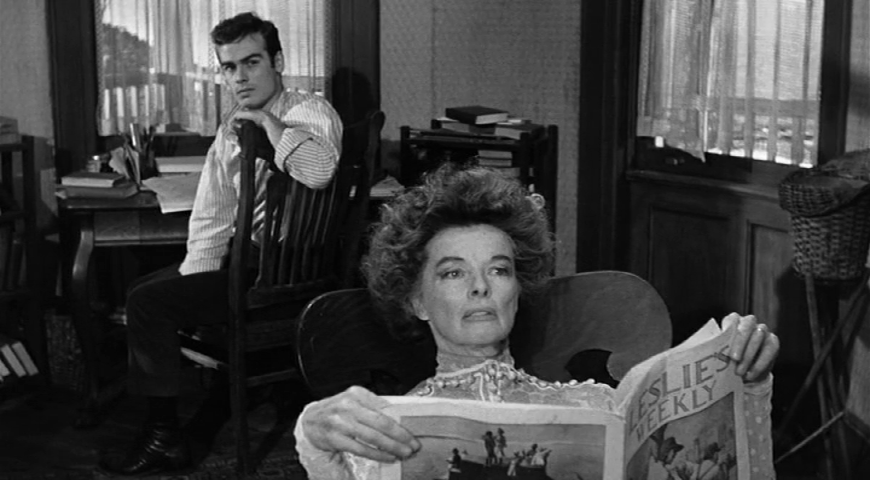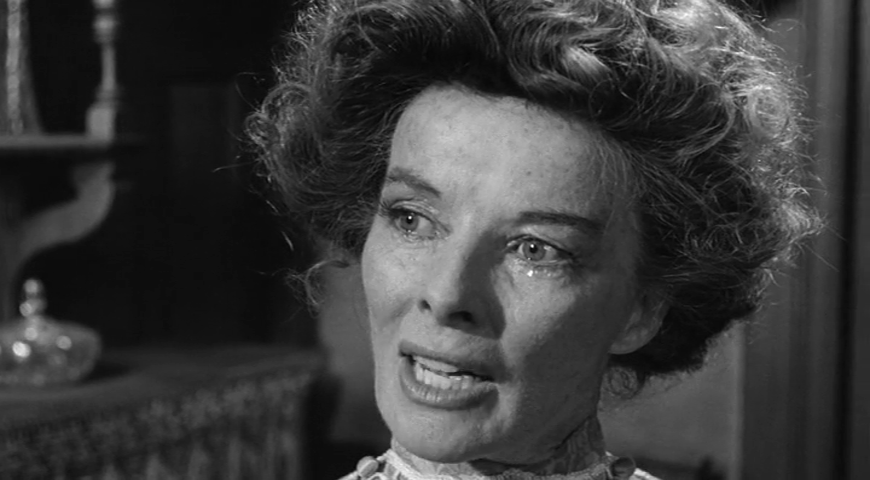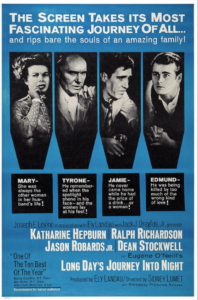|
Genres, Themes, Actors, and Directors:
- Alcoholism and Drug Addiction
- Dean Stockwell Films
- Family Problems
- Grown Children
- Jason Robards, Jr. Films
- Katharine Hepburn Films
- Play Adaptations
- Ralph Richardson Films
- Sidney Lumet Films
Review:
Sidney Lumet directed this first screen adaptation of Eugene O’Neill’s 1957 semi-autobiographical Broadway play, widely considered his magnum opus. Shot in sequence after three weeks of rehearsal, it tells a harsh, intentionally claustrophobic tale of deep-seated family dysfunctions emerging over the course of one “long day”. Hepburn was nominated for an Academy Award for her performance as Mary Tyrone, a matriarch prescribed morphine upon the challenging birth of her third son (after the early loss of her second) — and to that end, the central theme of a family member who becomes unwittingly addicted to prescription drugs (and simply can’t quit them) rings remarkably true and current.

Meanwhile, the tensions that inevitably emerge whenever grown children return to their parents’ household are shown in full force, with choices around money playing a particularly relevant role. To the credit of everyone involved in this production — from (deceased) O’Neill to Lumet, to the powerful cast, composer André Previn, and a highly capable crew — this undeniable downer of a story never lags, and remains surprisingly compelling throughout its nearly 3-hour running time. While it’s not for all tastes, film fanatics will likely appreciate watching it at least once.
Notable Performances, Qualities, and Moments:
- Katharine Hepburn as Mary

- Ralph Richardson as James Tyrone

- Dean Stockwell as Edmund

- Jason Robards, Jr. as Jamie

- Boris Kaufman’s cinematography

- André Previn’s intriguing score
Must See?
Yes, as a powerfully filmed adaptation of a classic American play. Listed as a film with Historical Importance and a Personal Recommendation in the back of Peary’s book.
Categories
Links:
|







One thought on “Long Day’s Journey Into Night (1962)”
Rewatch (7/23/22). A no-brainer must-see, as an undisputed American classic, boasting pitch-perfect performances and direction. As posted in ‘Film Junkie’ (fb):
“Then, in the Spring, something happened to me. Oh, yes – I remember. I fell in love with James Tyrone… and was so happy, for a time.”
‘Long Day’s Journey Into Night’ (1962): Eugene O’Neill finished writing the play in 1941; it had taken him two years to write. Then he put it away, having no desire to see it performed, ever – or published during his lifetime. Wikipedia tells us that “[i]n 1945 he had a sealed copy of the manuscript placed in the document vault of publisher Random House, instructing that it not be published until 25 years after his death.”
He died in 1953 – so, if his wishes had been carried out, the play would not have been performed until at least 1978. But his wife intervened for the sake of the work. In 1956, the play was first performed in Sweden (a country that felt a strong affinity for O’Neill’s plays). The following year, it opened on Broadway, winning the Tony for Best Play (also an award for leading actor Fredric March) as well as several other NY theater awards – and the Pulitzer Prize.
After Sidney Lumet’s film version opened at the Canne festival, Katherine Hepburn won a Best Actress award and her co-stars Ralph Richardson, Dean Stockwell and Jason Robards, Jr were each awarded Best Actor.
To me, the film is nearly flawless. It’s a work that achieves something very difficult to pull off: a sort of soap opera aiming for great tragedy. A story of chasing the dragon, it often seems to be chasing its own tail instead – with what (deceptively) sounds like a lot of repetitive vitriol and a narrative that can’t seem to remove itself from its circular thrust.
But, if you’re paying attention, the devil is in the details – as is the brilliance of the writing.
~and Lumet’s direction. And, primarily, the acting. With these four actors, this, as they say, is as good as it gets.
Reportedly, Hepburn said she was terrified to play Mary Tyrone. Actors are often at their best when they’re terrified to play a role. (I saw Vanessa Redgrave in the role in a Bway revival; a different approach but equally memorable.) She’s particularly good in her sequence alone with the maid Kathleen (Jeanne Barr). And her reminiscence of her considerable difficulties with childbirth would go over the heads (and black hearts) of a certain 6 SCOTUS justices. (The child who died young is, oddly enough, named ‘Eugene’ – but Stockwell, named Edmund, is O’Neill’s stand-in.)
I return to this film from time to time – and remain in awe of its richness and its capacity for uncompromising truth.